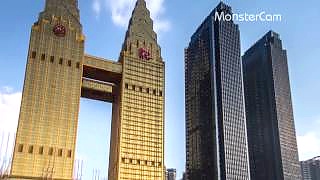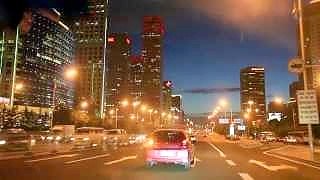ChongQing: 20 Kid-Friendly Places to Visit
- Chongqing Zoo (重庆动物园 Chóngqìng Dòngwùyuán): Visit pandas, tigers, and other animals in this zoo.
- Huguang Guild Hall (湖广会馆 Húguǎng Huìguǎn): Enjoy Sichuan opera performances and traditional arts.
- Three Gorges Museum (重庆中国三峡博物馆 Chóngqìng Zhōngguó Sānxiá Bówùguǎn): Learn about the history and culture of the Three Gorges region.
- Chongqing Science and Technology Museum (重庆科技馆 Chóngqìng Kējìguǎn): Discover interactive exhibits on science and technology.
- Chongqing Children's Library (重庆市儿童图书馆 Chóngqìng Shì Értóng Túshūguǎn): Explore a wide range of children's books and resources.
- Chongqing People's Square (重庆人民广场 Chóngqìng Rénmín Guǎngchǎng): Enjoy outdoor activities and cultural events in this central square.
- Chongqing Grand Theater (重庆大剧院 Chóngqìng Dàjùyuàn): Attend performances and concerts in this modern theater.
- Chongqing Happy Valley (重庆欢乐谷 Chóngqìng Huānlègǔ): Amusement park with thrilling rides and entertainment.
- Chongqing People's Park (重庆人民公园 Chóngqìng Rénmín Gōngyuán): Relax in green spaces and enjoy outdoor activities.
- Chongqing Zoo (重庆动物园 Chóngqìng Dòngwùyuán): Visit pandas, tigers, and other animals in this zoo.
- Huguang Guild Hall (湖广会馆 Húguǎng Huìguǎn): Enjoy Sichuan opera performances and traditional arts.
- Three Gorges Museum (重庆中国三峡博物馆 Chóngqìng Zhōngguó Sānxiá Bówùguǎn): Learn about the history and culture of the Three Gorges region.
- Chongqing Science and Technology Museum (重庆科技馆 Chóngqìng Kējìguǎn): Discover interactive exhibits on science and technology.
- Chongqing Children's Library (重庆市儿童图书馆 Chóngqìng Shì Értóng Túshūguǎn): Explore a wide range of children's books and resources.
- Chongqing People's Square (重庆人民广场 Chóngqìng Rénmín Guǎngchǎng): Enjoy outdoor activities and cultural events in this central square.
- Chongqing Grand Theater (重庆大剧院 Chóngqìng Dàjùyuàn): Attend performances and concerts in this modern theater.
- Chongqing Happy Valley (重庆欢乐谷 Chóngqìng Huānlègǔ): Amusement park with thrilling rides and entertainment.
- Chongqing People's Park (重庆人民公园 Chóngqìng Rénmín Gōngyuán): Relax in green spaces and enjoy outdoor activities.
ChongQing: 30 More Places to Visit
- Ciqikou Ancient Town (磁器口古镇 Cíqìkǒu Gǔzhèn): Explore historic streets, shops, and teahouses in this ancient town.
- Chongqing Art Museum (重庆美术馆 Chóngqìng Měishùguǎn): Discover contemporary and traditional Chinese art in this museum.
- Chongqing Great Hall of the People (重庆人民大礼堂 Chóngqìng Rénmín Dàlǐtáng): Visit this iconic building for cultural performances and events.
- Chongqing Wulong Karst National Geology Park (重庆武隆喀斯特国家地质公园 Chóngqìng Wǔlóng Kāsītè Guójiā Dìzhì Gōngyuán): Explore karst landscapes, caves, and natural wonders.
- Chongqing Chaotianmen Square (重庆朝天门广场 Chóngqìng Cháotiānmén Guǎngchǎng): Enjoy views of the Yangtze and Jialing rivers from this square.
- Chongqing Hongya Cave (重庆洪崖洞 Chóngqìng Hóngyá Dòng): Explore traditional architecture, shops, and restaurants in this cave complex.
- Chongqing Ronghui Hot Springs (重庆融汇温泉 Chóngqìng Rónghuì Wēnquán): Relax in natural hot springs and enjoy spa treatments.
- Chongqing Jiefangbei Pedestrian Street (重庆解放碑步行街 Chóngqìng Jiěfàngbēi Bùxíng Jiē): Shop for souvenirs, snacks, and electronics on this bustling street.
- Chongqing International Expo Center (重庆国际博览中心 Chóngqìng Guójì Bólǎn Zhōngxīn): Attend exhibitions, trade shows, and events in this modern venue.
- Chongqing Eling Park (重庆鹅岭公园 Chóngqìng Élǐng Gōngyuán): Enjoy panoramic views of Chongqing from this hilltop park.
- Chongqing Nanshan Botanical Garden (重庆南山植物园 Chóngqìng Nánshān Zhíwùyuán): Explore diverse plant collections and enjoy outdoor activities.
- Chongqing Stilwell Museum (重庆史迪威博物馆 Chóngqìng Shǐdíwēi Bówùguǎn): Learn about General Stilwell and World War II history in this museum.
- Chongqing Yangtze River Cableway (重庆长江索道 Chóngqìng Chángjiāng Suǒdào): Enjoy panoramic views of the Yangtze River from this cable car.
- Chongqing Railway Museum (重庆铁路博物馆 Chóngqìng Tiělù Bówùguǎn): Explore the history of railways in China at this museum.
- Chongqing Wansheng Black Valley (重庆万盛黑山谷 Chóngqìng Wànshèng Hēishān Gǔ): Discover scenic landscapes and outdoor activities in this valley.
- Chongqing Guanyin Bridge Pedestrian Street (重庆观音桥步行街 Chóngqìng Guānyīnqiáo Bùxíng Jiē): Shop for fashion, accessories, and souvenirs on this pedestrian street.
- Chongqing Wanzhou Pagoda (重庆万州白鹤塔 Chóngqìng Wànzhōu Báihè Tǎ): Visit this historic pagoda for panoramic views of the city.
- Chongqing Diaoyu Fortress (重庆钓鱼城 Chóngqìng Diàoyú Chéng): Explore ancient military fortifications and enjoy scenic views.
- Chongqing White Crane Forest Park (重庆白鹤林公园 Chóngqìng Báihè Lín Gōngyuán): Enjoy nature trails, wildlife, and birdwatching in this park.
- Chongqing Railway Museum (重庆铁路博物馆 Chóngqìng Tiělù Bówùguǎn): Explore the history of railways in China at this museum.
- Furong Cave (芙蓉洞 Fúróng Dòng): Discover stunning stalactites and stalagmites in this natural cave outside Chongqing.
- Qutang Gorge (瞿塘峡 Qútáng Xiá): Cruise through this scenic gorge on the Yangtze River.
Chongqing, often referred to as the 'Mountain City', is a vibrant metropolis located in southwestern China. It's a fascinating destination for tourists, offering a unique blend of natural beauty, rich cultural heritage, and modern urban development. Here's a guide for tourists visiting Chongqing:
City Highlights:
Geographical Features: Chongqing is renowned for its dramatic landscape, characterized by steep hills, towering skyscrapers, and the confluence of the Yangtze and Jialing rivers. The city's hilly terrain gives it a distinctive skyline and adds to its scenic beauty.
Three Gorges: As a gateway to the Three Gorges region, Chongqing serves as the starting point for Yangtze River cruises. Tourists can embark on cruises that traverse the picturesque Three Gorges, including Qutang Gorge, Wu Gorge, and Xiling Gorge, while experiencing the breathtaking scenery along the way.
Cultural Heritage: Chongqing boasts a rich cultural heritage with historical sites, temples, and museums that showcase its long history and cultural diversity. Must-visit attractions include the Dazu Rock Carvings, a UNESCO World Heritage site featuring intricate Buddhist sculptures, and the Three Gorges Museum, which offers insights into the region's natural and cultural history.
Culinary Delights: Chongqing is famous for its spicy Sichuan cuisine, particularly hotpot, a popular dish enjoyed by locals and visitors alike. Tourists can sample authentic Chongqing hotpot at local restaurants and street food stalls, savoring the bold flavors and fiery spices that characterize the region's cuisine.
Attractions and Activities:
Hongya Cave: This iconic riverside complex in downtown Chongqing features traditional architecture, colorful lights, and a bustling marketplace. Visitors can explore the labyrinthine alleyways, shop for souvenirs, and enjoy panoramic views of the Yangtze River from the elevated walkways.
Ciqikou Ancient Town: Nestled along the banks of the Jialing River, Ciqikou Ancient Town is a well-preserved historic district known for its Ming and Qing Dynasty architecture, charming tea houses, and artisan shops. It's a great place to stroll, shop for handicrafts, and sample local snacks.
Jiefangbei Pedestrian Street: As the commercial heart of Chongqing, Jiefangbei Pedestrian Street is a bustling shopping and entertainment district lined with shops, malls, theaters, and restaurants. It's a vibrant area to explore, especially at night when the neon lights illuminate the streets.
Wulong Karst Landscape: Located about 3 hours' drive from Chongqing, the Wulong Karst Landscape is a UNESCO World Heritage site renowned for its stunning karst formations, natural bridges, and caves. Visitors can hike, explore underground caverns, and admire the breathtaking scenery of this geological wonderland.
Practical Tips:
Transportation: Getting around Chongqing is convenient with its extensive public transportation network, including buses, taxis, and the Chongqing Metro. Cable cars and escalators also provide access to the city's hilly terrain.
Weather: Chongqing has a subtropical climate with hot summers and mild winters. Summer temperatures can be sweltering, so it's advisable to dress accordingly and stay hydrated.
Language: Mandarin Chinese is the official language spoken in Chongqing, although the local Chongqing dialect is also prevalent. It's helpful to carry a phrasebook or translator app, especially if you're not fluent in Mandarin.
Chongqing offers a captivating blend of natural beauty, cultural heritage, and modern urban life, making it an exciting destination for tourists seeking to explore the diverse landscapes and rich cultural heritage of southwestern China.

 50 places to visit in ChongQing
50 places to visit in ChongQing













